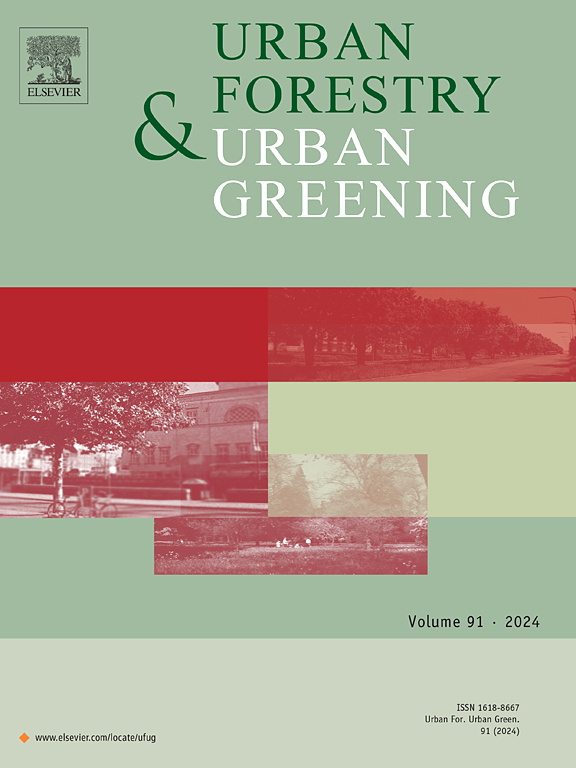提高医疗机构花园的生物多样性潜力:将草坪变成开花草地
IF 6
2区 环境科学与生态学
Q1 ENVIRONMENTAL STUDIES
引用次数: 0
摘要
医疗保健机构的花园可以对护理提供者和接受者的健康和福祉产生积极影响,同时有助于生物多样性保护。我们调查了2020年比利时北部878家医疗机构中这些花园的当前生态价值及其生物多样性潜力。在我们的调查中,大多数医疗机构对生物多样性对其护理提供者和接受者的影响感兴趣,70% %的医疗机构表示他们愿意加强其花园的生物多样性。只有三分之一的医疗机构有意识地将他们的花园作为治疗的一部分。大多数受访机构(96% %)在其处所设有一个或多个绿色元素。树木(89 %)和捷径草坪(87 %)最为常见,而花草甸相对较少(17 %)。我们考察了每个花园为目标物种或目标群体提供合适环境的潜力,以满足它们的生命周期,我们探索了三个例子:蝴蝶、地上筑巢的蜜蜂和高山蝾螈(alpestris)。几乎一半的花园(45% %)有可能为蝴蝶提供一个合适的环境,大约三分之一的花园(31% %)适合地上筑巢的蜜蜂,不到十分之一(9 %)适合高山蝾螈。短切草坪是一种管理成本高、生物多样性价值低的绿色元素,其共性表明园林内具有较高生态价值的绿色元素存在发展空间。我们将花草甸确定为一个绿色元素,具有增加花园生物多样性的高潜力。将捷径草坪变成物种丰富的花草地可能是医疗机构对生物多样性感兴趣的一个答案。本文章由计算机程序翻译,如有差异,请以英文原文为准。
Boosting biodiversity potential in gardens of healthcare institutions: Turning lawns into flowering meadows
Gardens of healthcare institutions can have a positive impact on the health and wellbeing of care providers and recipients, and at the same time contribute to biodiversity conservation. We surveyed the current ecological value of these gardens and their potential for biodiversity across 878 healthcare institutions in northern Belgium in 2020. The majority of these healthcare institutions in our survey were interested in the effects of biodiversity on their care providers and recipients, and 70 % of the healthcare institutions indicated they were willing to enhance the biodiversity of their garden. Only one in three healthcare institutions consciously used their garden as part of therapy. Most of the respondent institutions (96 %) had one or more green elements on their premises. Trees (89 %) and short-cut lawns (87 %) were most common, while flower meadows appeared to be relatively scarce (17 %). We looked at each garden’s potential to provide a suitable environment for target species or target groups to fulfill their lifecycle, which we explored for three examples: butterflies, aboveground nesting bees and the alpine newt (Ichthyosaura alpestris). Almost half of the gardens (45 %) had the potential to provide a suitable environment for butterflies, approximately one-third of the gardens (31 %) for the aboveground nesting bees and less than one tenth (9 %) for the alpine newt. The commonness of short-cut lawns, a green element characterized by high management costs and low biodiversity value, shows that there is room for green elements with a higher ecological value within the gardens. We identified flower meadows as a green element with a high potential of increasing the garden biodiversity. Turning short-cut lawns into species-rich flower meadows may be an answer to the biodiversity interest of the healthcare institutions.
求助全文
通过发布文献求助,成功后即可免费获取论文全文。
去求助
来源期刊

Urban Forestry & Urban Greening
FORESTRY-
CiteScore
11.70
自引率
12.50%
发文量
289
审稿时长
70 days
期刊介绍:
Urban Forestry and Urban Greening is a refereed, international journal aimed at presenting high-quality research with urban and peri-urban woody and non-woody vegetation and its use, planning, design, establishment and management as its main topics. Urban Forestry and Urban Greening concentrates on all tree-dominated (as joint together in the urban forest) as well as other green resources in and around urban areas, such as woodlands, public and private urban parks and gardens, urban nature areas, street tree and square plantations, botanical gardens and cemeteries.
The journal welcomes basic and applied research papers, as well as review papers and short communications. Contributions should focus on one or more of the following aspects:
-Form and functions of urban forests and other vegetation, including aspects of urban ecology.
-Policy-making, planning and design related to urban forests and other vegetation.
-Selection and establishment of tree resources and other vegetation for urban environments.
-Management of urban forests and other vegetation.
Original contributions of a high academic standard are invited from a wide range of disciplines and fields, including forestry, biology, horticulture, arboriculture, landscape ecology, pathology, soil science, hydrology, landscape architecture, landscape planning, urban planning and design, economics, sociology, environmental psychology, public health, and education.
 求助内容:
求助内容: 应助结果提醒方式:
应助结果提醒方式:


